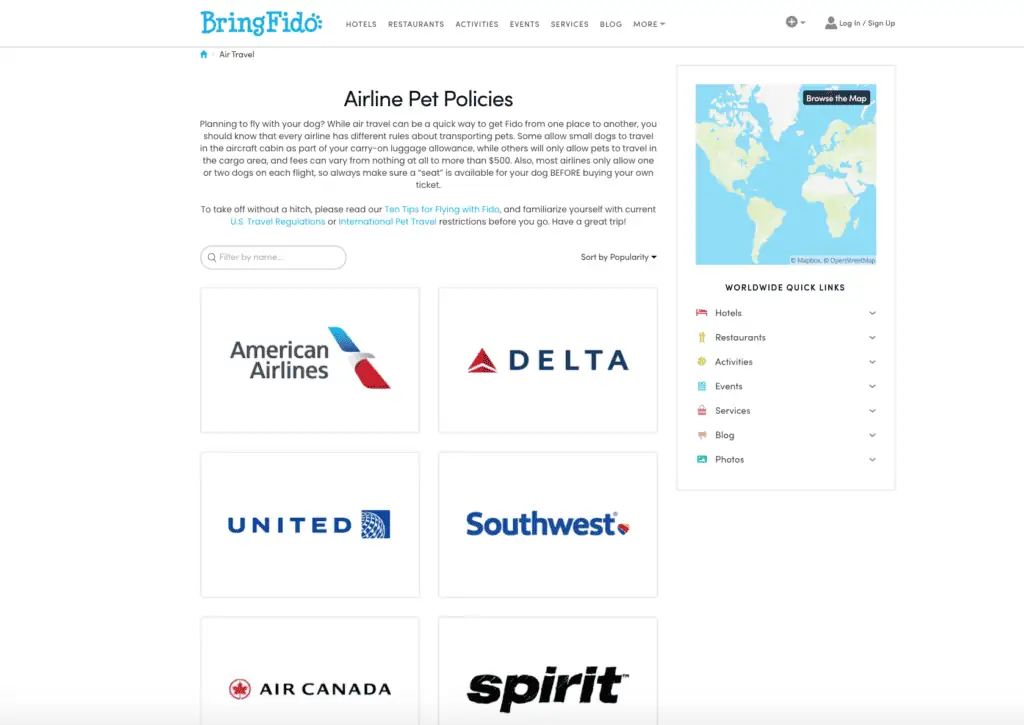Key Findings:
- Hawaii is the strictest state (Stringency Score 69.7 out of 100) for moving with animals, requiring both dogs and cats two rabies vaccinations and an antibody test, or to be placed in quarantine
- New York (68.8) and Nebraska (68.7) are the next hardest states to move with dogs and cats
- North Carolina (Stringency Score 13.8) is the most lenient state for incoming cats and dogs, followed by New Jersey (14.8) and Maine (25)
- Only one state – New Jersey – doesn’t require dogs to be vaccinated for rabies when moving to the state
- California, Michigan, New Jersey, Iowa, and Tennessee have stricter rules for dogs than cats
Moving to a new state can be a stressful experience when you have a furry friend to take along. Relocating with a pet requires additional planning and preparation, as the majority of states require cats and dogs to have a valid health certificate and a current rabies vaccination, at the minimum.
Some states, like New York or Nebraska, impose additional requirements for health certificates and vaccinations. Others, such as Maine or New Jersey, allow cats and dogs to move in without any proof of health status or vaccination at all. It can get kind of confusing!
Read on to see which states are the strictest in terms of moving with a pet, see which are the most lenient, and find out whether it’s cats or dogs that face the most scrutiny when moving across state lines.
Hard To Get Into Hawaii: States With the Strictest Rules for Pet Imports
No other state has pet migration rules as stringent as Hawaii.
Having been a rabies-free state for over 100 years, and the only state with that status, it’s understandable that the local government is keen to protect it.
That’s probably why Hawaii is the only state that requires cats and dogs to have a double rabies vaccination, a rabies antibody test, a microchip for identification, and inspection upon arrival.
If all the requirements aren’t met four months before arriving in Hawaii, the pet may not qualify for immediate release and be quarantined for five days, costing the owner $244 in fees.
“There is a cluster of states in the Northeast — namely New York, Connecticut, and Massachusetts — that have some of the strictest rules for certificates of veterinary inspection (CVI)…”
New York and Nebraska have the next strictest control measures for cats and dogs arriving from other states. Both states require animals to have a certificate of veterinary inspection (CVI) issued within 30 days of travel, listing a destination address and confirming no visible signs of infectious diseases.
In addition, the rabies vaccine is required for animals as young as three months and it must be administered at least 30 days prior to entering the state.
Other states where rules for bringing cats and dogs are relatively strict include West Virginia and Louisiana, where only 12-month (as opposed to 36-month) rabies vaccinations are recognized, and Connecticut, where the health certificate should state that the animal hadn’t been exposed to rabies for 100 days prior to entering the state.
See prices for local moving labor. Read real customer reviews. Easily book your help online.
North Carolina and New Jersey Most Open to Pet Arrivals
As some states impose rigorous rules on cats and dogs moving in, others appear to be welcoming their new feline and canine residents with open arms.
North Carolina, for example, is the easiest state to move to with a cat or a dog. The state doesn’t require animals to have a certificate of veterinary inspection (CVI) when entering the state. And, more importantly, animals aged four months or older can enter the state without a rabies vaccine, provided that they receive one within a week of arrival.
New Jersey is the second most lenient state with regard to pet imports. Here, 
The next states in our lenience ranking are Maine, Montana, and Utah, where the only requirement is a valid rabies vaccination.
Texas is another state where a CVI isn’t required for incoming cats or dogs, but at the same time, new feline and canine residents are to be vaccinated against rabies as soon as they are 12 weeks old.
North and South: Regional Differences in Rules for Moving with Pets
Projecting the rules set out by different states onto a map, a few curious patterns emerge.
Looking at the overall stringency of rules, the states where it’s the highest are generally in the northern part of the country. Hawaii and Louisiana, of course, are notable exceptions. This is largely mirrored in how strict states are in their requirements for veterinary inspections of incoming cats and dogs.
“It’s true that dogs have traditionally been associated with rabies, but they’re only the majority of cases in certain parts of the world. According to the CDC, there are many more rabid cats than dogs in the United States.”
There is a cluster of states in the Northeast — namely New York, Connecticut, and Massachusetts — that have some of the strictest rules for certificates of veterinary inspection (CVI) that every cat and dog coming to the state needs to have.
When it comes to regulations around the rabies vaccine, it’s the states in the South that generally have tighter rules. Texas, Louisiana, New Mexico, and Alabama stand out as some of the tightest requirements for rabies vaccination for cats and dogs entering these states.
Unequal Welcome: States with Varying Requirements for Cats and Dogs
More often than not, the rules for cats and dogs moving from one state to another are the same within a given state. And yet, seven states make moving in with one of America’s most beloved pet animals a lot easier than moving in with another one. And, you guessed it, it’s cats that have it easier.
This is most evident in the state of California, where dogs moving to the state need to be vaccinated against rabies and have a certificate of veterinary inspection (CVI), while cats are allowed to be brought to the state without adhering to these measures.
Michigan does require both cats and dogs to have a CVI, but only dogs need to be vaccinated against rabies before coming to the state, and this applies to dogs as young as 12 weeks of age.
Iowa and the aforementioned New Jersey are the two other states where the requirement to have your pet vaccinated against rabies only applies to dogs. Dogs may enter New Jersey without a rabies vaccine, but would need one to be licensed in most of the state’s municipalities.
“Hawaii is the strictest state (Stringency Score 69.7 out of 100) for moving with animals, requiring both dogs and cats require double rabies vaccinations and an antibody test, or be placed in quarantine.”
While it may seem like common sense, this double standard with regard to rabies vaccination for dogs and cats is somewhat dubious.
It’s true that dogs have traditionally been associated with rabies, but they’re only the majority of cases in certain parts of the world. According to the CDC, there are many more rabid cats than dogs in the United States.
Curious to see what rules each state sets out for bringing in cats and dogs? Check out our interactive table below.
Sources and Methodology
In order to rank all U.S. states and the District of Columbia on how stringent or lenient they are as regards the import of cats and dogs, rules for the importation of cats and dogs from other U.S. states or territories were gathered from the official government websites of each state.
The following factors were considered in determining how strict or relaxed the rules were in each state, with the weighted score assigned to each. The rules mostly revolved around the certificate of veterinary inspection (CVI) and rabies vaccination requirements:
-
Certificate of veterinary inspection (CVI) needed – 25 points
-
Within how many days of travel the CVI had to be issued – 10 points
-
Destination address in the state listed on CVI – 10 points
-
Explicit requirement of confirmation of disease-free status on CVI – 5 points
-
Rabies vaccine mandated before arrival – 25 points
-
Rabies vaccine types accepted (1-year or 3-year) – 5 points
-
Vaccinated at least X days before arrival – 5 points
-
Vaccination age threshold – 5 points
-
Other vaccine requirements (e.g., quarantine, additional tests, fees) – 15 points
The longer in advance the animal had to be vaccinated or inspected to get a CVI, the more stringent the rules were deemed. The lower the age threshold for vaccination, the stricter the rules were deemed.
States with the highest number of points were deemed more stringent, and states with the lower number of points were deemed more lenient. For states where requirements differed for cats and dogs, an average score of two sets of requirements was taken.
For the complete list of sources, check our datasheet.


 If you’re driving and your pet isn’t used to the vehicle, spend time familiarizing them with it, if possible. “When you are driving with your pet, it is safest to keep them restrained so they don’t become a distraction, physically impede your ability to control the car, or injure themselves or other occupants in case of an accident,” Coates says. You may need to invest in a crate that can be tethered using a seatbelt or wedged into a footwell. For larger dogs, look into getting a pet seat belt system.
If you’re driving and your pet isn’t used to the vehicle, spend time familiarizing them with it, if possible. “When you are driving with your pet, it is safest to keep them restrained so they don’t become a distraction, physically impede your ability to control the car, or injure themselves or other occupants in case of an accident,” Coates says. You may need to invest in a crate that can be tethered using a seatbelt or wedged into a footwell. For larger dogs, look into getting a pet seat belt system.






 How to move with a cat
How to move with a cat
 How to move with a reptile
How to move with a reptile



